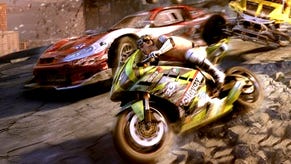MotorStorm Pacific Rift
Jungle fever.
Although there are still some sections where the vehicles carve their way through deep mud, there's less emphasis on track deformation in Pacific Rift than in the first. Terrain variety and dynamic, destructible track furniture move to the fore. The game's physics technology is very flexible and impressive, considering the sheer quantity of chaos MotorStorm throws around the screen. In the circumstances, it's not surprising to see the initial promises of fields of 20 racers reduced to 16 in this build of the game.
Water has drag and current, pushing vehicles off course; vegetation is flattened by big rigs, but can whiplash motorbike and ATV riders out their seats; piles of tyres, wooden water towers and sprung gates can be used as traps for your rivals, especially if you're driving a heavier machine. The new bunny-hop and duck abilities for the bike and ATV come in very useful in picking your way through these hazards, but your reactions will need to be very sharp. We loved the emergent unpredictability of the hazards, and sense of tactile connection to the game-world, but the physics is annoyingly inconsistent at times, with even the new monster trucks occasionally coming a cropper against fragile-looking sticks of track furniture.
Less attention-grabbing, but even more rewarding, is the new engine temperature system, wherein you can cool your engine (and so keep boosting longer) by driving through water, while passing near heat sources such as lava does the opposite. Only water came into play in the tracks we raced, but weighing up the delicate balance of temperature versus water drag versus racing line was an intriguing and satisfying new racing challenge. It's hard to see equivalent depth and interest in avoiding heat (or, presumably, sacrificing boost for short cuts), but it's up to Evolution's track designers to prove us wrong.

We wouldn't put it past them. The placement of water in Cascade Falls and Kanaloa Bay is extremely well thought-out, an object lesson in track design. MotorStorm's remit - wide-open, branching tracks, with multiple racing lines and balanced for multiple vehicle types - is perhaps the hardest design challenge in racing games, and the first game was consequently a little basic and messy in places. You can already tell that Pacific Rift is a tighter ship - in vehicle classes as well as track design, this game is looking much better tuned and balanced than its predecessor.
Unfortunately for Evolution and Sony, you can't put "it's just better" on the box. In terms of new features, Pacific Rift doesn't have much to boast beyond that split-screen play, and the one new vehicle class: the lolloping, bouncing, smashing, not-really-turning monster truck. There's a photo mode, mostly useful for pausing and slowly spinning the camera around the abundant moments of slapstick carnage in lush natural vistas.

There is a broader range of attacks, with left and right rams on the shoulder-buttons providing an irresistible, but rather dangerous, dart to the side that uses boost. The Sixaxis' motion sensors can be used to right a toppling vehicle after awkward landings and shunts, useful for the monster truck. There will be a proper matchmaking system for online multiplayer from launch this time. Best of all, there are 16 tracks to the original's eight.
It's all good stuff, but is it enough to push Pacific Rift? The first game sold a healthy 3.5 million copies on the back of the PS3 launch, but Pacific Rift has to elbow its way into a much more crowded line-up, and it's difficult to get excited about - superficially, at least. It would be a shame if this technically impressive, thoughtful, polished and exhilarating sequel ended up left in lesser games' dust.


